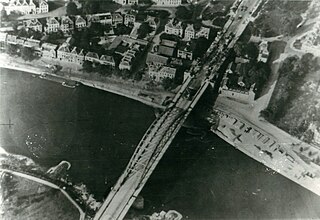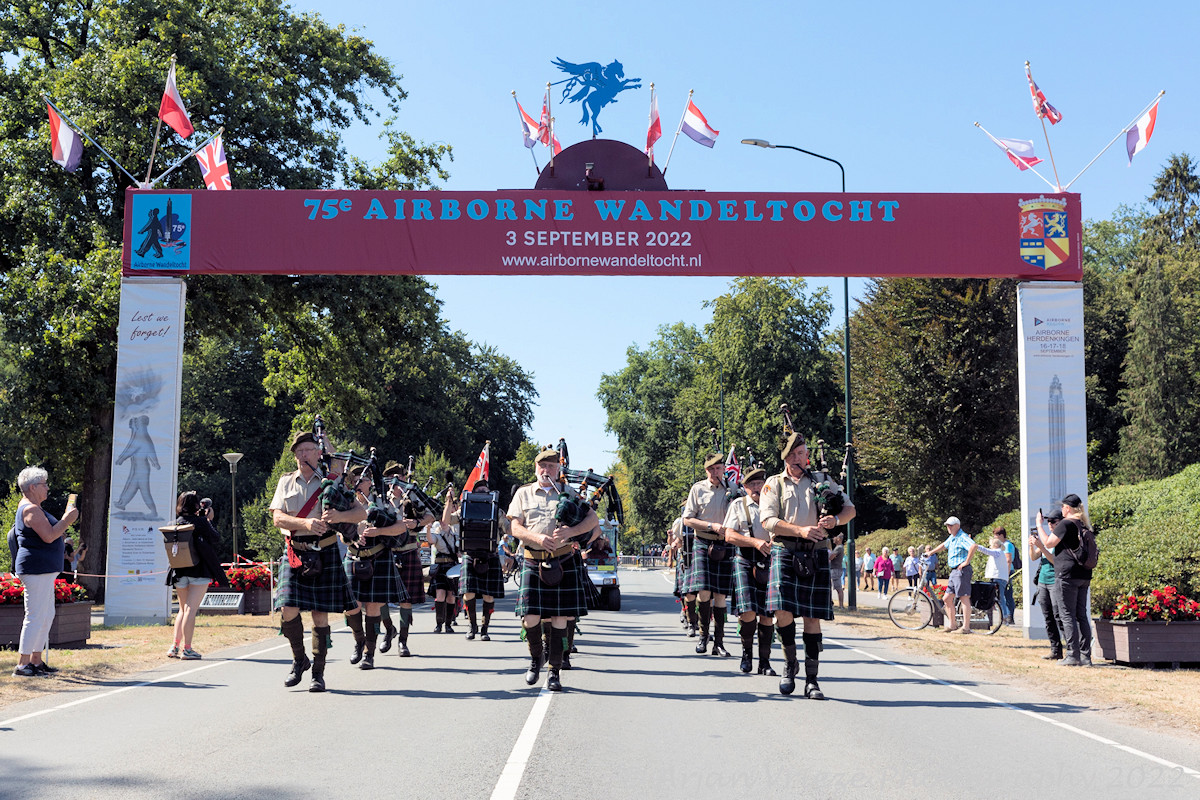
Operation Market Garden was an Allied military operation during the Second World War fought in the Netherlands from 17 to 27 September 1944. Its objective was to create a 64 mi (103 km) salient into German territory with a bridgehead over the River Rhine, creating an Allied invasion route into northern Germany. This was to be achieved by two sub-operations: Seizing nine bridges with combined U.S. and British airborne forces (Market) followed by land forces swiftly following over the bridges (Garden).

Cher Ami was a male homing pigeon who had been donated by the pigeon fanciers of Britain for use by the U.S. Army Signal Corps in France during World War I and had been trained by American pigeoners. He is famous for delivering a message from an encircled battalion despite serious injuries during the Meuse-Argonne offensive in October 1918.

The Battle of Arnhem was a battle of the Second World War at the vanguard of the Allied Operation Market Garden. It was fought in and around the Dutch city of Arnhem, the town of Oosterbeek, the villages Wolfheze and Driel and the vicinity from 17 to 26 September 1944. The Allies were poised to enter the Netherlands after sweeping through France and Belgium in the summer of 1944, after the Battle of Normandy. Operation Market Garden was proposed by Field Marshal Sir Bernard Montgomery, who favoured a single push northwards over the branches of the Lower Rhine River, allowing the British Second Army to bypass the Siegfried Line and attack the Ruhr. US Airborne troops were dropped in the Netherlands to secure bridges and towns along the line of the Allied advance. Farthest north, the British 1st Airborne Division landed at Arnhem to capture bridges across the Nederrijn, supported by men of the Glider Pilot Regiment and the 1st Polish Parachute Brigade. The British XXX Corps were expected to reach the British airborne forces in two to three days.

Operation Pegasus was a military operation carried out on the Lower Rhine near the village of Renkum, close to Arnhem in the Netherlands. Overnight on 22–23 October 1944, the Allied military forces, MI9, the British intelligence organization, and the Dutch Resistance successfully evacuated 138 men, mostly soldiers trapped in German-occupied territory who had been in hiding since the Battle of Arnhem.

Homing pigeons have long played an important role in war. Due to their homing ability, speed, and altitude, they were often used as military messengers. Carrier pigeons of the Racing Homer breed were used to carry messages in World War I and World War II, and 32 such pigeons were presented with the Dickin Medal.

The PDSA Dickin Medal was instituted in 1943 in the United Kingdom by Maria Dickin to honour the work of animals in World War II. It is a bronze medallion, bearing the words "For Gallantry" and "We Also Serve" within a laurel wreath, carried on a ribbon of striped green, dark brown, and pale blue. It is awarded to animals that have displayed "conspicuous gallantry or devotion to duty while serving or associated with any branch of the Armed Forces or Civil Defence Units". The award is commonly referred to as "the animals' Victoria Cross".

G.I. Joe was a pigeon noted for his service in the United States Army Pigeon Service. The bird is part of the homing pigeons used during World War I and World War II for communication and reconnaissance purposes. G.I. Joe had the name tag, Pigeon USA43SC6390. He was hatched in March 1943, in Algiers, North Africa and underwent a training for two-way homing pigeons perfected at Fort Monmouth, in New Jersey.

The United States Army Pigeon Service was a unit of the United States Army during World War I and World War II. Their assignment was the training and usage of homing pigeons for communication and reconnaissance purposes.
Paddy was an Irish carrier pigeon awarded the Dickin Medal after being the fastest pigeon to arrive back in England with news of the success of the D-Day invasion, out of hundreds dispatched. He flew 230 miles across the English Channel in four hours and fifty minutes, the fastest recorded crossing, and was awarded the medal on 1 September 1944, just under three months after the crossing. Paddy was trained by Andrew Hughes of Carnlough and is the only animal in Ireland to be awarded this medal. The medal citation reads,
"For the best recorded time with a message from the Normandy Operations, while serving with the RAF in June, 1944."

According to a 2007 newspaper report, Source Columba was the code name for the Confidential Pigeon Service, an unconventional British intelligence gathering operation in World War II.

The Airborne March is the annual Dutch commemorative event in remembrance of the Battle of Arnhem in September 1944, that began in 1947 and always takes place on the first Saturday in September at Oosterbeek near Arnhem in The Netherlands. Just over 34,800 people took part in the 68th edition of the march in 2014.

Commando was a pigeon used in service with the British armed forces during the Second World War to carry crucial intelligence. The pigeon carried out more than ninety missions during the war, and received the Dickin Medal for three particularly notable missions, in 1945. The medal was later sold at an auction for £9,200.
The National Pigeon Service (NPS) was a volunteer civilian organization formed in Britain in 1938 as result of representations made to the Committee of Imperial Defence and the British Government by Major W. H. Osman. During 1939-45 over 200,000 young pigeons were given to the services by the British pigeon breeders of the NPS. The birds were used by the Royal Air Force and the Army and Intelligence Services, Special Section of the Army Pigeon Service. During three and a half years of World War II, 16,554 war pigeons were parachuted onto the continent. One of these was Commando, a red chequer cock bird that became a recipient of the Dickin Medal. Many other NPS pigeons also received the Dickin Medal.
Gustav, also known as NPS.42.31066, was a pigeon of the RAF pigeon service. He was awarded the Dickin Medal, also known as the animals' Victoria Cross, for bringing the first report of the Normandy landings to the British mainland during the Second World War.
Tyke, also known as 'George' and carrying the service number 1263 MEPS 43, was a male Second World War homing pigeon who was awarded the Dickin Medal for gallantry in 1943 for delivering a message from a downed aircrew. His medal was sold for £4,830 ($7,313) in July 2000.
Beach Comber was a Canadian war pigeon who received the Dickin Medal for bravery in service during the Second World War.
Dutch Coast, also known as NURP.41. A.2164, was a pigeon who received the Dickin Medal in 1945 from the People's Dispensary for Sick Animals for bravery in service during the Second World War.
Scotch Lass was a carrier pigeon who received the Dickin Medal in June 1945 from the People's Dispensary for Sick Animals for bravery in service during the Second World War. She accompanied a British agent on a mission into The Netherlands. Immediately after she was released, in September 1944, and still in view of the agent that had released her, she hit telegraph wires. However, she carried on and delivered her message and photographs.
NURP.43.CC.1418 was a pigeon who received the Dickin Medal in 1947 from the People's Dispensary for Sick Animals for bravery in service during the Second World War. NURP.43 received the citation for the fastest flight carrying a message from the 6th Airborne Division from Normandy on 7 June 1944, while serving with the National Pigeon Service.










